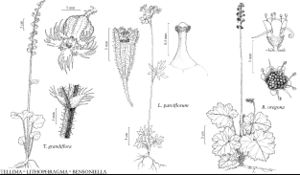Difference between revisions of "Bensoniella"
Leafl. W. Bot. 10: 181. 1965 ,.
FNA>Volume Importer |
FNA>Volume Importer |
(No difference)
| |
Revision as of 23:01, 16 December 2019
Herbs, not rhizomatous, not stoloniferous; caudex slender, scaly. Flowering stems erect or ascending, leafless, 19–45 cm, stipitate-glandular. Leaves in basal rosette; stipules present; petiole long stipitate-glandular; blade orbiculate to cordate, 5–9-lobed, sinuses relatively shallow, base cordate, ultimate margins unevenly crenate, apex rounded, surfaces long stipitate-glandular along veins abaxially, sparsely long stipitate-glandular adaxially; venation palmate. Inflorescences spikelike racemes, from axillary buds of basal rosette, 15–30-flowered, ebracteate. Flowers slightly bilaterally symmetric, base gibbous on abaxial side; hypanthium 1/3 adnate to ovary proximally, free from ovary 0.5–0.8 mm, yellowish white to green; sepals 5, yellowish white to green; petals absent or 5, purple or pink; nectary tissue not seen or inconspicuous; stamens 5, opposite sepals; filaments filiform; ovary 1/3 inferior, 1-locular; placentation parietal; styles 2; stigmas 2. Capsules 2-beaked. Seeds dark brown, oblong to ellipsoid, smooth. x = 7.
Distribution
w United States.
Discussion
Bensonia Abrams & Bacigalupi, Contr. Dudley Herb. 1: 95, plate 5, fig. 1. 1929, not Buckman 1845 (fossil)
Species 1: w United States.
Although the floral morphology of Bensoniella is quite distinctive, vegetative similarities suggest a connection with the otherwise equally distinctive genus Mitella. Molecular data (D. E. Soltis et al. 1990), as well as karyotype analysis (Soltis 1988), clearly show a close relationship between the genera.
Species 1
Selected References
None.
